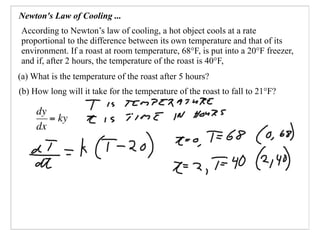AP Calculus Slides April 16, 2007
•
0 recomendaciones•1,854 vistas
Applications of differential equations sample problems.
Denunciar
Compartir
Denunciar
Compartir
Descargar para leer sin conexión

Recomendados
Recomendados
Más contenido relacionado
La actualidad más candente
La actualidad más candente (20)
Destacado (6)
Similar a AP Calculus Slides April 16, 2007
Similar a AP Calculus Slides April 16, 2007 (6)
Más de Darren Kuropatwa
Más de Darren Kuropatwa (20)
Tales of Learning and the Gifts of Footprints v4.2

Tales of Learning and the Gifts of Footprints v4.2
AP Calculus Slides April 16, 2007
- 1. Newton's Law of Cooling ... According to Newton’s law of cooling, a hot object cools at a rate proportional to the difference between its own temperature and that of its environment. If a roast at room temperature, 68°F, is put into a 20°F freezer, and if, after 2 hours, the temperature of the roast is 40°F, (a) What is the temperature of the roast after 5 hours? (b) How long will it take for the temperature of the roast to fall to 21°F?
- 3. (b) How long will it take (a) What is the for the temperature of the temperature of the roast to fall to 21°F? roast after 5 hours?
- 4. Cooling Colas A few weekends ago we invited some friends over and served them lunch. The day before we had bought some cans of soda, but we didn't have enough room in our refrigerator to cool the colas. Since it was February my wife suggested that we leave the cans outside overnight to cool. The overnight temperature was to be in the twenties, so I was afraid they might freeze; however, I figured out a way to approximate the temperature of the cola at any given time. First, I read the thermometer in our house. It said 72°F. Next I read our outdoor thermometer, and it read 25°F. I put the cola outside for 30 minutes and then brought one of the cans inside to have a drink. Before I drank the soda, I measured the temperature. The temperature of the soda was 60°F. Based on this information, how long would it take the cola to cool to 35°F? Assume that the outdoor temperature remains constant during the cooling process.
- 7. Hot Cocoa You have just poured yourself a nice mug of hot chocolate. As you lift up the mug to take a sip, you realize the hot chocolate is too hot. You don't want to burn your tongue, so you decide to wait. You walk over to the thermometer on the wall and note that the room temperature is 70°F degrees. You assume that the temperature of the hot chocolate is about 200°F degrees, because you added water that was almost boiling to the mug. You would like to wait until the hot chocolate is about 150°F degrees. You use a thermometer to measure the temperature of the hot chocolate. After 2 minutes of cooling, it is at 190°F degrees. To the nearest minute, how much longer will you need to wait? Answer on next slide ...
- 8. It will take 12 minutes after the coffee begins cooling from 200 degrees in a 70 degree room to reach 150 degrees. You have already waited 2 minutes. Since 12 - 2 = 10 there remain 10 minutes before you can comfortably take a sip.
